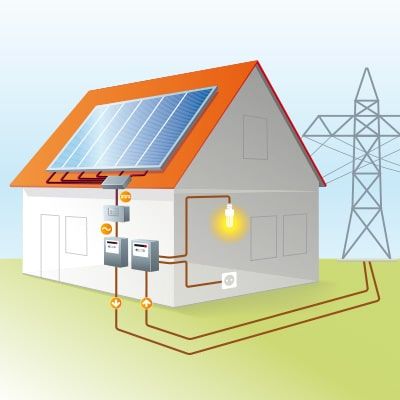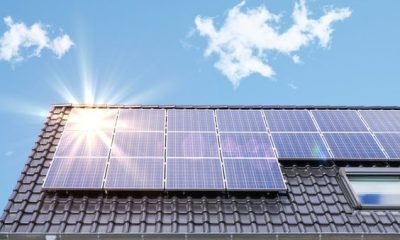Home Solar Energy
How To Sell Excess Solar Electricity Back To Your Utility Company

How to Sell Excess Solar Electricity Back to Your Utility Company
Introduction
Harnessing the power of the sun through solar panels is not just a way to reduce your carbon footprint; it’s also a means to potentially earn money by selling excess solar electricity back to your utility company. This guide will walk you through the process of turning your surplus energy into a revenue stream while contributing to a cleaner and more sustainable energy future.
Understanding Net Metering
What is Net Metering?
Net metering is a system that allows homeowners and businesses with solar power systems to connect to the grid and exchange excess electricity for credits on their utility bills. In essence, it’s like a two-way street for electricity: you can both draw power from the grid when your solar panels aren’t producing enough and sell your excess energy back when they’re generating more than you need.
How Net Metering Works
When your solar panels produce more electricity than you consume, the surplus is fed back into the grid. A bi-directional meter tracks this flow in both directions, allowing you to accumulate credits during times of excess generation. These credits can then be used when your panels are less productive, such as during the night or on cloudy days.
Eligibility and Regulations
Eligibility for net metering programs varies by location and utility company. It’s crucial to research your local regulations and check with your utility provider to ensure you meet the eligibility criteria. These regulations might include the size of your solar system, the type of meter required, and any specific agreements you need to enter into with the utility company.
In conclusion, net metering is the foundational concept that enables you to sell excess solar electricity back to your utility company. It’s a win-win arrangement that not only helps you save on energy costs but also contributes to a more sustainable energy grid. In the next sections of this guide, we will delve deeper into the steps involved, from installing your solar power system to contacting your utility provider and maximizing your returns.
Installing a Solar Power System
Investing in a solar power system is the first step toward selling excess solar electricity back to your utility company. This section will guide you through the crucial aspects of selecting and installing the right system for your needs.
Choosing the Right Solar System
1. Assess Your Energy Needs: Begin by evaluating your household or business’s energy consumption. This assessment will help you determine the size of the solar system you need to install. Consider factors like your location, average sunlight hours, and the appliances you use.
2. Type of Solar Panels: Choose the type of solar panels that best suit your needs. Monocrystalline, polycrystalline, and thin-film panels all have their advantages and costs. Research and consult with solar professionals to make an informed decision.
3. Find a Reputable Installer: Selecting a reliable solar installer is crucial. Look for certified professionals with a track record of successful installations. Request quotes from multiple installers to compare prices and services.
Installation Process
1. Site Assessment: The installer will assess your property to determine the best location for the panels. This assessment considers factors such as roof condition, shading, and local regulations.
2. Permits and Approvals: Ensure that you obtain the necessary permits and approvals from local authorities and your utility company. Your installer should help with this process.
3. Panel Installation: Once all paperwork is in order, the solar panels will be installed on your roof or at a ground-mounted location. This process involves mounting the panels securely and connecting them to the electrical system.
4. Grid Connection: After installation, your solar system needs to be connected to the grid. This involves installing a bi-directional meter that can measure both the electricity you consume and the surplus you feed back into the grid.
By installing a solar power system, you’re not only generating clean energy for your use but also creating the foundation for selling excess electricity back to your utility company. The next sections of this guide will focus on monitoring your energy production, calculating excess energy, and contacting your utility provider to initiate the process.
Monitoring Energy Production
Once your solar power system is up and running, it’s essential to monitor its energy production to effectively manage and sell your excess solar electricity. This section will explore methods to track your system’s performance.
Tracking Solar Energy Generation
1. Inverter Data: Most solar power systems are equipped with inverters that provide real-time data on energy production. You can access this information through a dedicated monitoring system or a mobile app provided by the manufacturer.
2. Solar Monitoring Services: Some solar companies offer monitoring services that provide detailed insights into your system’s performance. These services may include daily, monthly, or yearly reports on energy generation.
Using a Smart Meter
1. Bi-Directional Meter: As part of your solar system installation, a bi-directional meter was likely installed. This meter tracks the flow of electricity between your system and the grid. It’s a crucial tool for accurately measuring the surplus electricity you feed back into the grid.
2. Reading the Meter: Learn how to read your bi-directional meter to understand how much excess energy you’re producing. The readings will help you determine the credits you earn and can use in the future.
Understanding Your Energy Consumption
1. Consumption Patterns: To maximize the benefits of selling excess solar electricity, it’s essential to understand your energy consumption patterns. Identify peak usage hours and consider shifting energy-intensive tasks to times when your panels are producing surplus electricity.
2. Energy-Saving Practices: Implement energy-saving practices in your home or business to reduce your overall energy consumption. This will result in more excess electricity available for sale.
Monitoring your solar energy production and consumption is a fundamental part of selling excess solar electricity. In the upcoming sections of this guide, we will discuss how to calculate your excess energy, contact your utility company, and understand rate structures and compensation options to make the most of your renewable energy investment.
Calculating Excess Energy
Calculating the excess solar energy your system generates is a crucial step in the process of selling it back to your utility company. In this section, we’ll explore methods to determine your surplus electricity.
Determining Surplus Electricity
1. Monitoring Data: Utilize the data provided by your inverter or monitoring service to calculate the surplus energy. This information will show the amount of electricity your solar panels produce beyond what you consume.
2. Daily and Monthly Analysis: Review the data on a daily and monthly basis to understand the variations in surplus energy production. This will help you plan for peak production periods.
Monthly or Annual Surplus
1. Evaluate Your Needs: Decide whether you want to calculate your surplus on a monthly or annual basis. Monthly calculations may be more practical for smaller systems, while larger installations might benefit from an annual assessment.
2. Consult with Your Utility: Contact your utility company to discuss their preferred method for surplus energy calculations. They may have specific guidelines in place.
Calculating your excess solar energy is an important step in the process, as it will help you determine the amount of energy you can sell back to your utility company. In the following sections, we will delve into the process of contacting your utility provider, understanding rate structures and compensation options, and the necessary steps for metering and billing.
Contacting Your Utility Company
To begin the process of selling excess solar electricity back to your utility company, you’ll need to establish communication and provide the necessary documentation. In this section, we’ll guide you through the steps to get in touch with your utility provider.
Notifying the Utility Provider
1. Contact Information: Locate the contact details for your utility company. You can usually find this information on your utility bills or their official website.
2. Notify of Solar Installation: Reach out to your utility provider and inform them that you’ve installed a solar power system. This step is essential for them to update their records and prepare for the bi-directional meter installation.
Necessary Documentation
1. System Documentation: Gather all relevant documentation related to your solar power system, including installation certificates, warranty information, and technical specifications. This will help the utility company verify your system’s eligibility for net metering.
2. Account Information: Be prepared to provide your utility account details and any identification required to ensure your account is accurately linked to your solar installation.
3. Interconnection Agreement: In some cases, the utility company may require you to sign an interconnection agreement outlining the terms and conditions of connecting your solar system to the grid. Review this agreement carefully before signing.
4. Meter Installation Appointment: Coordinate with the utility company to schedule the installation of a bi-directional meter, if it hasn’t been installed already. This meter is crucial for accurately measuring the electricity you feed back into the grid.
Once you’ve contacted your utility provider and provided the necessary documentation, you’re on your way to selling your excess solar electricity. In the subsequent sections of this guide, we’ll explore rate structures and compensation options, the metering and billing process, as well as important considerations regarding taxes and incentives.
Rate Structure and Compensation
Understanding how you’ll be compensated for the excess solar electricity you provide to the grid is crucial. In this section, we’ll explore rate structures and compensation options.
Understanding Rate Structures
1. Net Metering: Most utility companies use net metering, which allows you to receive credits on your bill for the excess electricity you feed back into the grid. These credits can offset your future electricity costs when your solar panels aren’t producing enough.
2. Feed-In Tariffs (FITs): Some regions offer feed-in tariffs, where the utility company pays you a fixed rate for each kilowatt-hour of surplus energy. This rate is often set by regulatory authorities and can provide a predictable income.
Compensation Options
1. Credit Accumulation: With net metering, the credits you earn can accumulate over time. This means that if you generate more energy in sunny months, you can use those credits during months with less sunlight.
2. Direct Payments: If your utility company offers a feed-in tariff, you may receive direct payments for the surplus energy you provide. These payments can be a source of income in addition to reducing your energy bills.
3. Hybrid Approaches: Some utilities offer a combination of net metering and feed-in tariffs. It’s important to understand which approach your utility provider follows.
Negotiating Rates
1. Rate Negotiation: In some cases, you may have the opportunity to negotiate the rate at which you’re compensated. It’s advisable to research the average rates in your area and be prepared to discuss the terms with your utility company.
2. Changing Tariffs: Be aware that tariffs and compensation rates can change over time. Stay informed about any revisions in rates or policies that might affect your compensation.
Understanding the rate structure and compensation options available in your area is vital for making the most of your excess solar electricity. In the subsequent sections of this guide, we will explore the metering and billing process, tax considerations, and tips for maximizing your returns on this renewable energy investment.
Metering and Billing
The metering and billing process for selling excess solar electricity back to your utility company is a critical aspect of the arrangement. In this section, we’ll explain the key steps involved in this process.
Installing a Bi-Directional Meter
1. Meter Installation: The bi-directional meter, which was likely installed during your solar system setup, records both the electricity you consume from the grid and the surplus electricity you feed back into the grid.
2. Meter Reading: The meter provides readings of these two directions of electricity flow, allowing your utility provider to accurately track your energy production and consumption.
Billing Process and Credits
1. Credit Accumulation: As your solar panels generate surplus electricity, the bi-directional meter accumulates credits on your account for the excess energy you provide. These credits are used to offset your future electricity bills.
2. Billing Statements: Review your utility bills regularly to understand how many credits you have accumulated and how they are being applied to reduce your costs.
3. Accounting for Surplus: Ensure that your utility provider accurately accounts for the surplus energy you provide. If you notice discrepancies, contact your provider to address any billing issues promptly.
Selling excess solar electricity to your utility company is a transparent process thanks to the bi-directional meter and billing system. By monitoring your credits and bills, you can stay informed about the financial benefits of your solar power system.
In the subsequent sections of this guide, we will cover tax and incentive considerations, along with tips for maximizing your returns on your renewable energy investment.
How to Sell Excess Solar Electricity
Tax and Incentive Considerations
Understanding the tax implications and potential incentives related to selling excess solar electricity is important for maximizing your returns. This section explores these considerations.
Federal and State Incentives
1. Federal Tax Credits: The U.S. offers a federal investment tax credit (ITC) that allows you to claim a percentage of your solar system’s cost as a tax credit. The exact percentage can vary, so check for current rates.
2. State and Local Incentives: Many states and local governments offer additional incentives, such as rebates, grants, or tax credits, to encourage solar adoption. Research the incentives available in your area.
Tax Implications
1. Income Tax: The income generated from selling excess solar electricity might be subject to income tax. Consult a tax professional to understand how this applies to your specific situation.
2. Property Tax: Some states offer property tax exemptions for solar installations, reducing the tax burden on your property’s value.
3. Resale Sales Tax: In some states, you may be required to collect sales tax on the electricity you sell to your utility company. Ensure you comply with any local tax regulations.
Consult a Tax Professional
Given the complexity of tax implications and the availability of incentives, it’s advisable to consult a tax professional or accountant with experience in renewable energy. They can help you navigate the tax code and ensure you take full advantage of available incentives.
Understanding the tax and incentive landscape can significantly impact the financial benefits of selling excess solar electricity. In the next section, we’ll provide tips for maximizing returns and making the most of your renewable energy investment.
Tips for Maximizing Returns
Selling excess solar electricity back to your utility company can be a rewarding endeavor, both environmentally and financially. Here are some tips to help you maximize your returns:
Energy-Saving Practices
1. Implement energy-efficient practices in your home or business to reduce overall energy consumption. This not only saves money but also ensures more surplus energy is available for sale.
2. Schedule energy-intensive tasks, such as laundry and dishwashing, during peak solar production hours to use your own solar-generated electricity.
Energy Storage
1. Consider investing in an energy storage system (e.g., batteries) to store excess energy for later use. This can be particularly beneficial during times when your panels are not producing, such as at night.
Seasonal Planning
1. Understand the seasonal variations in solar energy production in your area. Plan for energy use accordingly and store excess energy when production is high for use during less productive periods.
Regular Maintenance
1. Keep your solar panels well-maintained to ensure they operate at peak efficiency. This includes cleaning panels, inspecting for damage, and promptly addressing any issues
Stay Informed
1. Stay informed about changes in rate structures, policies, and incentives. Regulations and compensation rates can evolve, so being aware of these changes is crucial.
Energy Audits
1. Consider conducting an energy audit to identify areas where you can further reduce energy consumption and increase the surplus available for sale.
By following these tips, you can make the most of your investment in a solar power system and effectively sell excess solar electricity back to your utility company. This not only benefits your bottom line but also contributes to a more sustainable energy future.
Conclusion
Selling excess solar electricity to your utility company is a rewarding venture that allows you to contribute to a cleaner environment while saving money and potentially earning income. By understanding the process of net metering, installing the right solar system, monitoring energy production, and considering tax and incentive implications, you can make the most of your renewable energy investment. With the right knowledge and proactive practices, you can harness the power of the sun to its fullest potential.
















